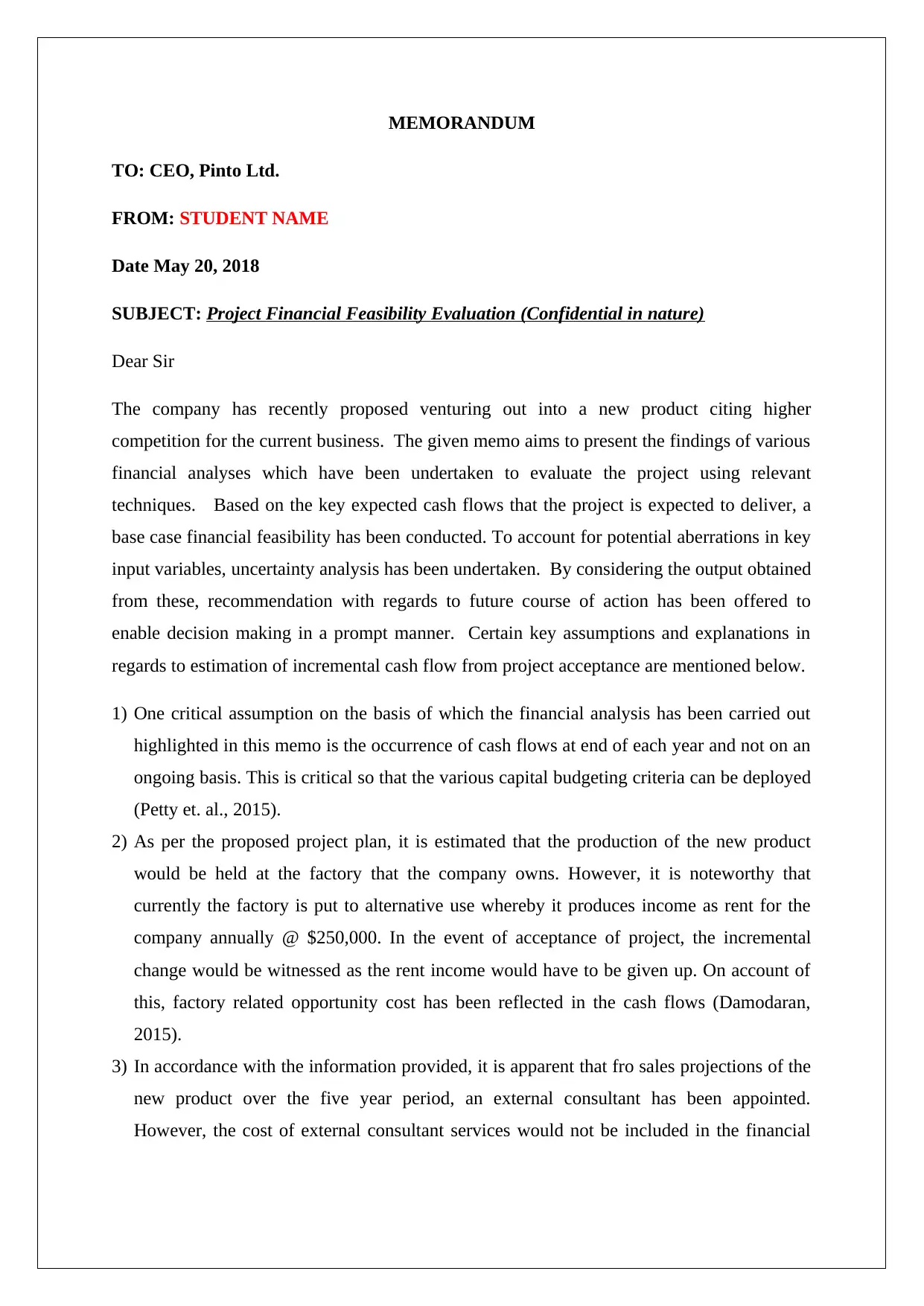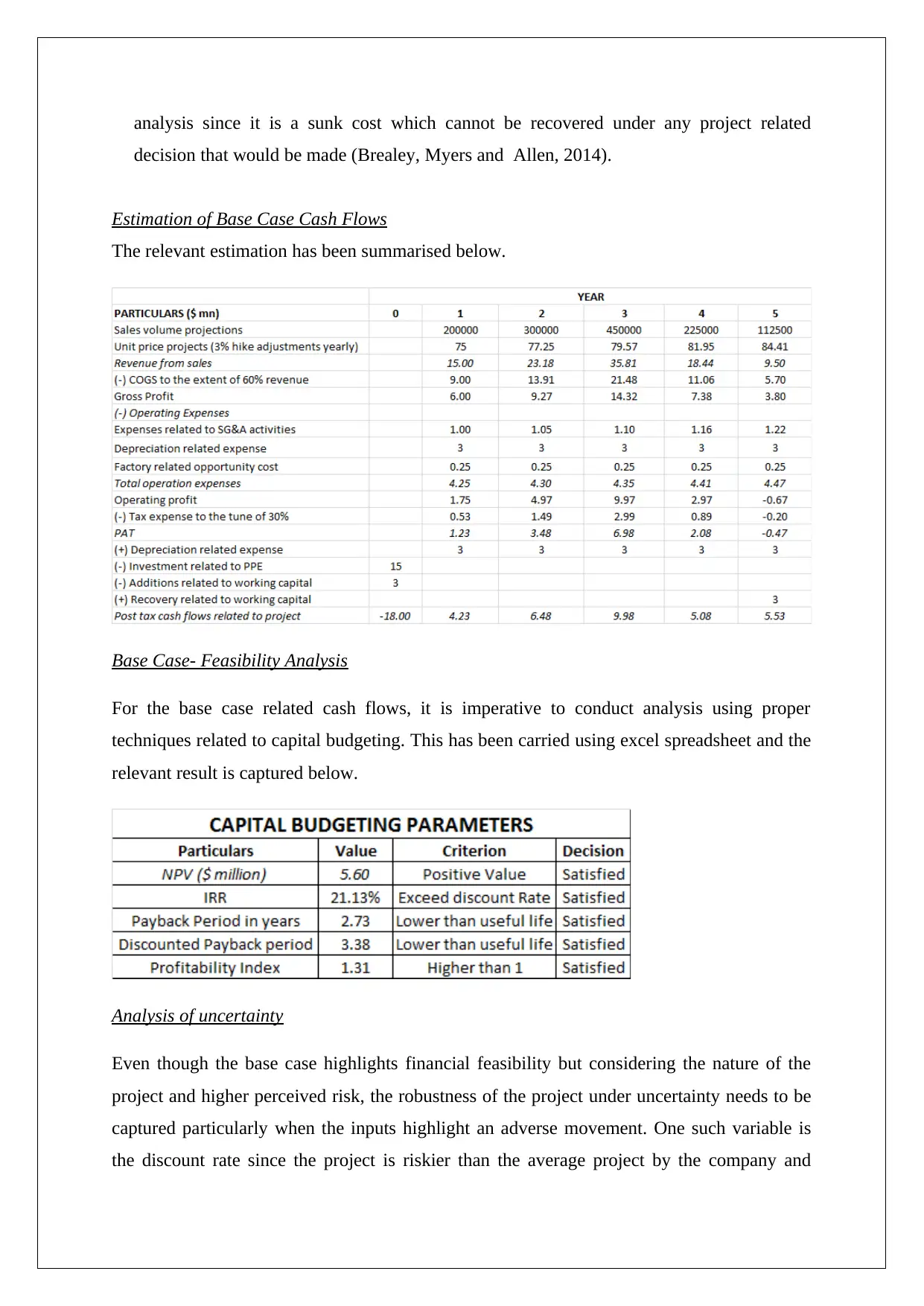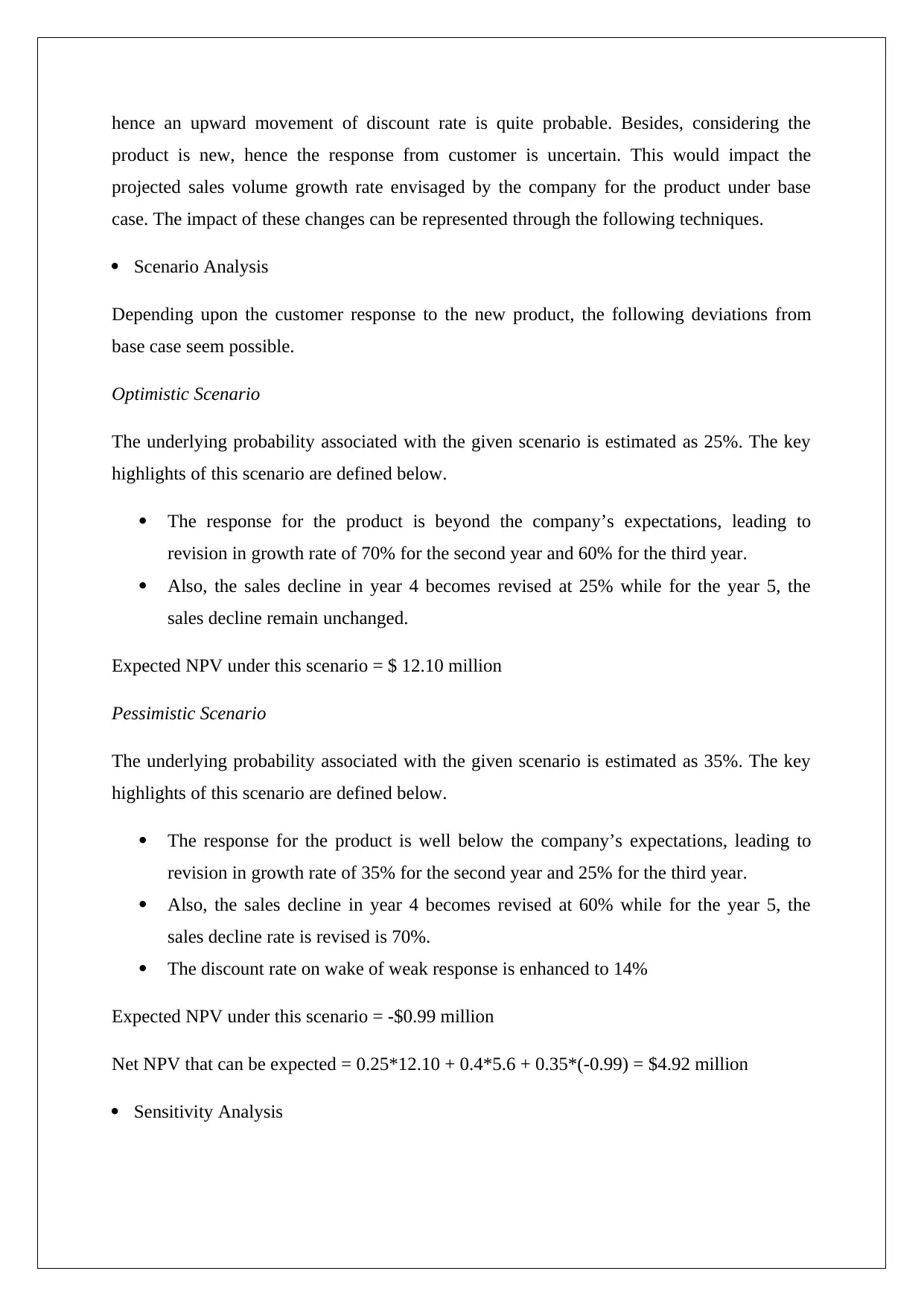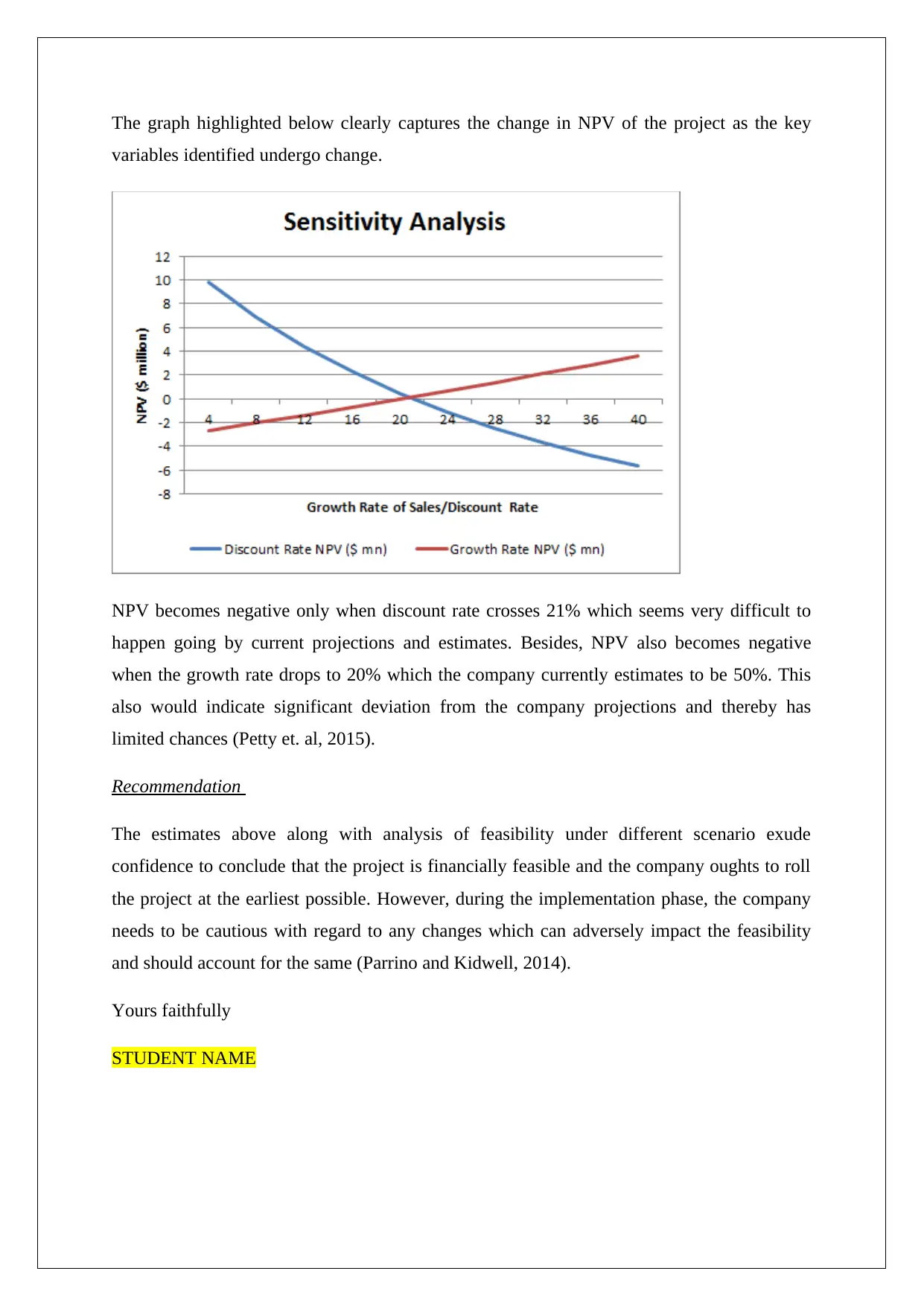ACC00716 Finance: Pinto Ltd Project Financial Feasibility Analysis
VerifiedAdded on 2023/06/12
|6
|1156
|275
Case Study
AI Summary
This document presents a financial feasibility evaluation of a new project proposed by Pinto Ltd, addressing increased competition. It includes a base case analysis using capital budgeting techniques and an uncertainty analysis considering variables like discount rate and sales volume growth. Scenario analysis (optimistic and pessimistic) and sensitivity analysis are employed to assess project robustness. The memo recommends project implementation but advises caution during the implementation phase to account for potential adverse changes. The analysis considers opportunity costs, sunk costs, and provides a recommendation based on NPV, IRR, and other financial metrics. Desklib offers a wealth of resources including similar case studies and solved assignments for students.

FINANCE
MEMORANDUM
STUDENT ID:
[Pick the date]
MEMORANDUM
STUDENT ID:
[Pick the date]
Paraphrase This Document
Need a fresh take? Get an instant paraphrase of this document with our AI Paraphraser

MEMORANDUM
TO: CEO, Pinto Ltd.
FROM: STUDENT NAME
Date May 20, 2018
SUBJECT: Project Financial Feasibility Evaluation (Confidential in nature)
Dear Sir
The company has recently proposed venturing out into a new product citing higher
competition for the current business. The given memo aims to present the findings of various
financial analyses which have been undertaken to evaluate the project using relevant
techniques. Based on the key expected cash flows that the project is expected to deliver, a
base case financial feasibility has been conducted. To account for potential aberrations in key
input variables, uncertainty analysis has been undertaken. By considering the output obtained
from these, recommendation with regards to future course of action has been offered to
enable decision making in a prompt manner. Certain key assumptions and explanations in
regards to estimation of incremental cash flow from project acceptance are mentioned below.
1) One critical assumption on the basis of which the financial analysis has been carried out
highlighted in this memo is the occurrence of cash flows at end of each year and not on an
ongoing basis. This is critical so that the various capital budgeting criteria can be deployed
(Petty et. al., 2015).
2) As per the proposed project plan, it is estimated that the production of the new product
would be held at the factory that the company owns. However, it is noteworthy that
currently the factory is put to alternative use whereby it produces income as rent for the
company annually @ $250,000. In the event of acceptance of project, the incremental
change would be witnessed as the rent income would have to be given up. On account of
this, factory related opportunity cost has been reflected in the cash flows (Damodaran,
2015).
3) In accordance with the information provided, it is apparent that fro sales projections of the
new product over the five year period, an external consultant has been appointed.
However, the cost of external consultant services would not be included in the financial
TO: CEO, Pinto Ltd.
FROM: STUDENT NAME
Date May 20, 2018
SUBJECT: Project Financial Feasibility Evaluation (Confidential in nature)
Dear Sir
The company has recently proposed venturing out into a new product citing higher
competition for the current business. The given memo aims to present the findings of various
financial analyses which have been undertaken to evaluate the project using relevant
techniques. Based on the key expected cash flows that the project is expected to deliver, a
base case financial feasibility has been conducted. To account for potential aberrations in key
input variables, uncertainty analysis has been undertaken. By considering the output obtained
from these, recommendation with regards to future course of action has been offered to
enable decision making in a prompt manner. Certain key assumptions and explanations in
regards to estimation of incremental cash flow from project acceptance are mentioned below.
1) One critical assumption on the basis of which the financial analysis has been carried out
highlighted in this memo is the occurrence of cash flows at end of each year and not on an
ongoing basis. This is critical so that the various capital budgeting criteria can be deployed
(Petty et. al., 2015).
2) As per the proposed project plan, it is estimated that the production of the new product
would be held at the factory that the company owns. However, it is noteworthy that
currently the factory is put to alternative use whereby it produces income as rent for the
company annually @ $250,000. In the event of acceptance of project, the incremental
change would be witnessed as the rent income would have to be given up. On account of
this, factory related opportunity cost has been reflected in the cash flows (Damodaran,
2015).
3) In accordance with the information provided, it is apparent that fro sales projections of the
new product over the five year period, an external consultant has been appointed.
However, the cost of external consultant services would not be included in the financial

analysis since it is a sunk cost which cannot be recovered under any project related
decision that would be made (Brealey, Myers and Allen, 2014).
Estimation of Base Case Cash Flows
The relevant estimation has been summarised below.
Base Case- Feasibility Analysis
For the base case related cash flows, it is imperative to conduct analysis using proper
techniques related to capital budgeting. This has been carried using excel spreadsheet and the
relevant result is captured below.
Analysis of uncertainty
Even though the base case highlights financial feasibility but considering the nature of the
project and higher perceived risk, the robustness of the project under uncertainty needs to be
captured particularly when the inputs highlight an adverse movement. One such variable is
the discount rate since the project is riskier than the average project by the company and
decision that would be made (Brealey, Myers and Allen, 2014).
Estimation of Base Case Cash Flows
The relevant estimation has been summarised below.
Base Case- Feasibility Analysis
For the base case related cash flows, it is imperative to conduct analysis using proper
techniques related to capital budgeting. This has been carried using excel spreadsheet and the
relevant result is captured below.
Analysis of uncertainty
Even though the base case highlights financial feasibility but considering the nature of the
project and higher perceived risk, the robustness of the project under uncertainty needs to be
captured particularly when the inputs highlight an adverse movement. One such variable is
the discount rate since the project is riskier than the average project by the company and
⊘ This is a preview!⊘
Do you want full access?
Subscribe today to unlock all pages.

Trusted by 1+ million students worldwide

hence an upward movement of discount rate is quite probable. Besides, considering the
product is new, hence the response from customer is uncertain. This would impact the
projected sales volume growth rate envisaged by the company for the product under base
case. The impact of these changes can be represented through the following techniques.
Scenario Analysis
Depending upon the customer response to the new product, the following deviations from
base case seem possible.
Optimistic Scenario
The underlying probability associated with the given scenario is estimated as 25%. The key
highlights of this scenario are defined below.
The response for the product is beyond the company’s expectations, leading to
revision in growth rate of 70% for the second year and 60% for the third year.
Also, the sales decline in year 4 becomes revised at 25% while for the year 5, the
sales decline remain unchanged.
Expected NPV under this scenario = $ 12.10 million
Pessimistic Scenario
The underlying probability associated with the given scenario is estimated as 35%. The key
highlights of this scenario are defined below.
The response for the product is well below the company’s expectations, leading to
revision in growth rate of 35% for the second year and 25% for the third year.
Also, the sales decline in year 4 becomes revised at 60% while for the year 5, the
sales decline rate is revised is 70%.
The discount rate on wake of weak response is enhanced to 14%
Expected NPV under this scenario = -$0.99 million
Net NPV that can be expected = 0.25*12.10 + 0.4*5.6 + 0.35*(-0.99) = $4.92 million
Sensitivity Analysis
product is new, hence the response from customer is uncertain. This would impact the
projected sales volume growth rate envisaged by the company for the product under base
case. The impact of these changes can be represented through the following techniques.
Scenario Analysis
Depending upon the customer response to the new product, the following deviations from
base case seem possible.
Optimistic Scenario
The underlying probability associated with the given scenario is estimated as 25%. The key
highlights of this scenario are defined below.
The response for the product is beyond the company’s expectations, leading to
revision in growth rate of 70% for the second year and 60% for the third year.
Also, the sales decline in year 4 becomes revised at 25% while for the year 5, the
sales decline remain unchanged.
Expected NPV under this scenario = $ 12.10 million
Pessimistic Scenario
The underlying probability associated with the given scenario is estimated as 35%. The key
highlights of this scenario are defined below.
The response for the product is well below the company’s expectations, leading to
revision in growth rate of 35% for the second year and 25% for the third year.
Also, the sales decline in year 4 becomes revised at 60% while for the year 5, the
sales decline rate is revised is 70%.
The discount rate on wake of weak response is enhanced to 14%
Expected NPV under this scenario = -$0.99 million
Net NPV that can be expected = 0.25*12.10 + 0.4*5.6 + 0.35*(-0.99) = $4.92 million
Sensitivity Analysis
Paraphrase This Document
Need a fresh take? Get an instant paraphrase of this document with our AI Paraphraser

The graph highlighted below clearly captures the change in NPV of the project as the key
variables identified undergo change.
NPV becomes negative only when discount rate crosses 21% which seems very difficult to
happen going by current projections and estimates. Besides, NPV also becomes negative
when the growth rate drops to 20% which the company currently estimates to be 50%. This
also would indicate significant deviation from the company projections and thereby has
limited chances (Petty et. al, 2015).
Recommendation
The estimates above along with analysis of feasibility under different scenario exude
confidence to conclude that the project is financially feasible and the company oughts to roll
the project at the earliest possible. However, during the implementation phase, the company
needs to be cautious with regard to any changes which can adversely impact the feasibility
and should account for the same (Parrino and Kidwell, 2014).
Yours faithfully
STUDENT NAME
variables identified undergo change.
NPV becomes negative only when discount rate crosses 21% which seems very difficult to
happen going by current projections and estimates. Besides, NPV also becomes negative
when the growth rate drops to 20% which the company currently estimates to be 50%. This
also would indicate significant deviation from the company projections and thereby has
limited chances (Petty et. al, 2015).
Recommendation
The estimates above along with analysis of feasibility under different scenario exude
confidence to conclude that the project is financially feasible and the company oughts to roll
the project at the earliest possible. However, during the implementation phase, the company
needs to be cautious with regard to any changes which can adversely impact the feasibility
and should account for the same (Parrino and Kidwell, 2014).
Yours faithfully
STUDENT NAME

References
Brealey, R. A., Myers, S. C., & Allen, F. (2014) Principles of corporate finance, 2nd ed. New
York: McGraw-Hill Inc.
Damodaran, A. (2015). Applied corporate finance: A user’s manual 3rd ed. New York:
Wiley, John & Sons.
Parrino, R. and Kidwell, D. (2014) Fundamentals of Corporate Finance, 3rd ed. London:
Wiley Publications
Petty, J.W., Titman, S., Keown, A., Martin, J.D., Martin, P., Burrow, M., & Nguyen, H. (2015).
Financial Management, Principles and Applications, 6th ed.. NSW: Pearson Education, French
Forest Australia.
Brealey, R. A., Myers, S. C., & Allen, F. (2014) Principles of corporate finance, 2nd ed. New
York: McGraw-Hill Inc.
Damodaran, A. (2015). Applied corporate finance: A user’s manual 3rd ed. New York:
Wiley, John & Sons.
Parrino, R. and Kidwell, D. (2014) Fundamentals of Corporate Finance, 3rd ed. London:
Wiley Publications
Petty, J.W., Titman, S., Keown, A., Martin, J.D., Martin, P., Burrow, M., & Nguyen, H. (2015).
Financial Management, Principles and Applications, 6th ed.. NSW: Pearson Education, French
Forest Australia.
⊘ This is a preview!⊘
Do you want full access?
Subscribe today to unlock all pages.

Trusted by 1+ million students worldwide
1 out of 6
Related Documents
Your All-in-One AI-Powered Toolkit for Academic Success.
+13062052269
info@desklib.com
Available 24*7 on WhatsApp / Email
![[object Object]](/_next/static/media/star-bottom.7253800d.svg)
Unlock your academic potential
Copyright © 2020–2025 A2Z Services. All Rights Reserved. Developed and managed by ZUCOL.





